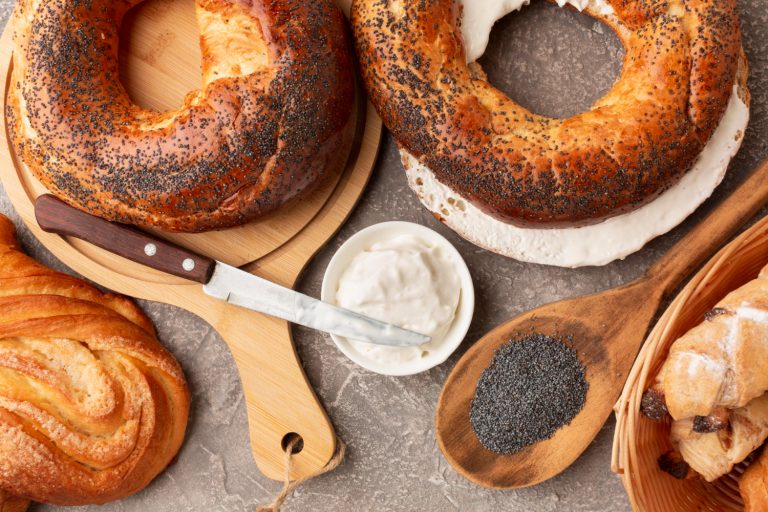How to Calculate Food Costs for Sourdough Bread: A Step-by-Step Guide
The difference between profit and loss in selling sourdough bread depends on accurate food cost calculations. Many bakers find it hard to price their artisanal loaves correctly. They often set prices too low or don’t account for their actual production costs, which makes it challenging to run a profitable business. Bakers need to understand the costs of ingredients, labor, and overhead to make smart pricing decisions.
This detailed piece shows you how to calculate food cost percentages and set profitable prices for sourdough bread. You’ll learn to track ingredient costs and manage labor expenses effectively. The guide covers overhead costs and helps determine the right profit margins. You’ll also find practical pricing tips and industry measures to stay competitive in your local market.
Understanding Food Cost Percentage
Food cost percentage is a vital metric that helps bakeries maintain profitability and set the right prices. Bakers use this basic calculation to effectively understand the relationship between ingredient costs and revenue.
What is the food cost percentage?
The food cost percentage measures how much your sales revenue goes toward ingredient costs. A simple formula calculates this ratio:
Food Cost Percentage = (Total Ingredient Cost / Total Revenue) × 100
A sourdough loaf that costs $2.06 to make and sells for $6.00 has a food cost percentage of 34.3%.
Why it matters for sourdough bread
Understanding food cost percentage becomes especially important to sourdough bread production because:
- The numbers help you spot ingredient costs that eat into your profits
- Your pricing decisions stay informed as ingredient costs change
- The profit margins remain stable despite seasonal changes in ingredient costs
Industry Standards
Successful bakeries keep their food costs within these specific ranges:
| Type of Operation | Target Food Cost Percentage |
|---|---|
| Standard Bakeries | 28-32% |
| Fine Dining Bakeries | Up to 35% |
| Quick-Service Bakeries | 25-30% |
These percentages work as guidelines, but each bakery’s ideal food cost percentage depends on several factors. Location, concept, and overhead costs play crucial roles. Some bakeries thrive with a 40% food cost percentage when they manage other costs well. Others might struggle even at 20% because of high labor or overhead expenses.
Success comes from balancing quality ingredients for authentic sourdough bread with healthy profit margins. These numbers are the foundations for smart decisions about pricing, menu engineering, and business strategy.
Calculating Ingredient Costs
Accurate ingredient cost calculation starts with proper documentation and standardized measurements to give consistent pricing and profitability for each sourdough bread loaf.
List all ingredients
A simple sourdough bread needs these ingredients:
| Ingredient | Typical Quantity |
|---|---|
| Bread Flour | 500g |
| Active Starter | 150g |
| Water | 250g |
| Salt | 10g |
| Olive Oil (optional) | 25g |
Determine the cost per unit
Accurate calculation of ingredient costs requires standardization to kilograms. Bakers need a systematic approach to tracking their expenses, which involves several simple steps.
- Note the purchase price for each ingredient package
- Change all package weights to kilograms
- Calculate cost per kilogram by dividing total cost by weight
- Create a spreadsheet that tracks these calculations
This method is illustrated by a practical example: A $10.00 25-pound bag of flour (11.3 kg) yields a cost per kilogram of $0.88.
Calculate the cost per loaf
A total ingredient cost per loaf reflects the combined costs of individual ingredients used in specific recipe quantities. Market prices show that a simple sourdough loaf’s ingredient costs typically range between $1.00 and $2.00. The final cost depends on flour quality and recipe variations.
The precise cost calculation requires three steps:
- Each ingredient quantity multiplied by its unit cost
- All ingredient costs added together for the batch
- Total batch cost divided by the number of loaves
Standard flour prices provide a good example:
- Flour (500g): $0.44
- Salt (10g): $0.08
- Starter maintenance: $0.64 daily
Your final calculations should include a waste factor of 5-10%. This additional percentage covers unavoidable production losses, such as dough stuck to equipment or unsuccessful batches. The waste factor will give a more realistic cost estimate and help set appropriate prices.
Factoring in Labor and Overhead
Labor and overhead expenses substantially affect the total production cost of sourdough bread beyond ingredient costs. Bakers who understand these components can set reasonable prices and run profitable operations.
Estimating labor costs
Labor makes up much of the production costs, especially when making artisanal sourdough bread. Skilled bakers expect rates starting at $18.00 per hour based on their expertise and specialized knowledge. The time-tracking process should monitor active work periods and exclude passive fermentation times.
Production costs change substantially based on batch size:
- Small batch (4 loaves): 2 hours active work = $9.00 per loaf
- Large batch (24 loaves): 20 minutes total = $0.25 per loaf
Including fixed costs
Fixed costs stay the same regardless of your production volume. These costs include several essential components:
| Expense Category | Monthly Cost Range |
|---|---|
| Utilities | $45-60 |
| Equipment Depreciation | $30-50 |
| Insurance | $50-100 |
| Packaging | $0.45-0.75 per loaf |
The straight-line method helps calculate equipment depreciation. A simple example shows how this works: a $1,000 mixer that lasts 5 years with a $100 salvage value has an annual depreciation of $180.
Allocating costs per loaf
The total cost allocation process covers everything in the following steps:
- Calculate monthly fixed expenses
- Add utility and depreciation costs
- Include packaging expenses
- Divide by monthly production volume
A home baker who produces 100 loaves monthly typically sees these overhead costs per loaf:
- Utilities: $0.45
- Depreciation: $0.30
- Packaging: $0.50
The total overhead comes to $1.25 per loaf without labor costs. Your overhead costs per unit drop by a lot when you make larger batches. This makes production more profitable as your volume grows.
Pricing Your Sourdough Bread
The right price for sourdough bread requires considering several factors and market trends. Smart pricing balances production costs with customer expectations and helps the business make steady profits.
Using the food cost percentage
Bakers want to price their bread based on the total production cost to achieve a food cost percentage between 28-35%. The calculation is straightforward. A loaf that costs $3.30 to produce (including ingredients, labor, and overhead) with a target food cost percentage of 30% would be priced using this formula:
Selling Price = Total Cost ÷ Target Food Cost Percentage
$3.30 ÷ 0.30 = $11.00
Determining profit margin
Artisanal bakeries want to achieve specific profit margins that vary by their size:
| Operation Size | Target Profit Margin |
|---|---|
| Small-scale (home-based) | 5-15% |
| Medium-scale | 10-20% |
| Large-scale | 15-25% |
Your profit margin should cover business development, equipment replacement, and market changes. Bright bakers review and adjust their margins based on the following:
- Ingredient costs that change with seasons
- Shifts in market demand
- Competitor’s prices
- Production quantities
Setting a competitive price
Market research is a vital part of setting your final price. Today’s market shows artisanal sourdough bread sells between $6.00 and $15.00 per loaf. Size, ingredients, and location drive these prices. Here’s what makes a premium product stand out:
Quality Differentiation
- Organic ingredients
- Traditional methods
- Unique flavors
Market Positioning
- Local competition analysis
- Target customer demographics
- Sales channel considerations
Smart bakers don’t just copy their competitors’ prices. They think over their unique value and calculate production costs carefully. High-quality artisanal sourdough can command 30% more than standard market prices if the bread’s quality matches its price tag.
Your prices need regular reviews to stay profitable as markets shift. The most successful bakeries adjust their prices with the seasons, or at the same time, costs change significantly. These bakeries stay open with customers about how quality ingredients and traditional methods justify premium prices.
Conclusion
Successful sourdough bread pricing requires focusing on several cost elements and market factors. Smart bakers create solid pricing models that boost business growth by monitoring ingredient costs, calculating labor expenses, and including overhead costs. These complete calculations and smart market positioning help artisanal bakers set the right prices that show their products’ true value and maintain healthy profit margins.
Bakers succeed when they analyze costs regularly and adjust prices based on market shifts and production efficiency. Premium positioning comes from quality ingredients, skilled craftsmanship, and clear pricing that builds customer trust. Bakers can learn more strategies and resources at The Yeast We Can Do. This platform offers detailed tutorials and pricing tips that help artisanal bakers improve their operations and expand their businesses.
FAQs
What is the formula for calculating food cost percentage?
To determine the food cost percentage, use the formula: (Total Cost of Goods Sold / Total Revenue) x 100. Begin by conducting a thorough inventory count, noting the costs associated with each item. Regular inventory checks are crucial for maintaining accurate records.
What is the cost range for making a loaf of sourdough bread at home?
The basic cost to bake a loaf of sourdough bread at home ranges from USD 1.00 to USD 2.00, depending on the type of flour used. Considering additional expenses like labor and energy, the cost per loaf could increase to USD 5.00 and USD 20.00.
How do you calculate the cost of producing a loaf of bread?
First, to calculate the cost of producing a loaf of bread, add up the costs of all the ingredients. Then, could you divide this total by the number of loaves you plan to sell? For example, if making five 2-pound loaves, divide the total ingredient cost by 5.
What price range can homemade sourdough bread be sold for?
Homemade sourdough bread can typically be sold for between USD 10.00 and USD 12.00 per loaf. Initially, prices might be higher (around USD 15.00), but market competition, such as at farmers’ markets, may require pricing adjustments to stay competitive.
How should I price my homemade sourdough to ensure a good profit margin?
Consider your production costs and prevailing market rates to price your homemade sourdough effectively. Calculate your total costs, including ingredients, labor, and overhead, and then set a price that covers these costs while offering a competitive edge. Adjust your pricing strategy based on customer feedback and market demand to ensure profitability.






